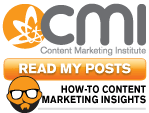 As you know from Press Release: Whittemore Re-Appointed to SURFACES '10 Education Advisory Council, Paul Friederichsen from BrandBiz, Inc. [on the left], Scott Perron from Big Bob's of America [in the middle] and I will jointly present a workshop at Surfaces 2010. The subject: brand marketing, advertising/promotion, and social media to effectively connect with retail consumers and generate business.
As you know from Press Release: Whittemore Re-Appointed to SURFACES '10 Education Advisory Council, Paul Friederichsen from BrandBiz, Inc. [on the left], Scott Perron from Big Bob's of America [in the middle] and I will jointly present a workshop at Surfaces 2010. The subject: brand marketing, advertising/promotion, and social media to effectively connect with retail consumers and generate business.Although our immediate focus relates to flooring, the lessons and discussion apply to any business or industry.
Scott, Paul and I will be collaborating intensely over the next few months as we build our workshop. I plan on documenting our process and discussions here on Simple Marketing Blog as a reference and also to include you in what we create. With your feedback, we will fine-tune our materials for added relevance and usefulness.
We might even ask that you test drive some of our ideas....
During our kick-off session at Hanley Wood's offices, we realized that we frequently hear one question in particular from businesses of all sizes, shapes, and forms: how to effectively use marketing to build a business. Perhaps a basic question, but truly a profound one.
Here's how Wikipedia defines marketing: "an integrated communications-based process through which individuals and communities discover that existing and newly-identified needs and wants may be satisfied by the products and services of others"
Critical to the success of this communications-based process is Strategy. Strategy ensures that your brand message relates to what you offer customers in your marketplace, and that you consistently implement it across all aspects of your business - in-store, on you website, through your advertising and promotions, across all of your customer communications including customer service and any community building and social programs. All elements must work in concert and focus in on your customer and how best to offer relevant value to her [women represent our core consumer certainly in flooring and also across the majority of purchase categories].
 That means that you have to think about how and why you might select one platform over another to implement aspects of your marketing plan.
That means that you have to think about how and why you might select one platform over another to implement aspects of your marketing plan.How you train your in-store associates matters as much as those on phone support or those who install your products in your customers' homes.
How you speak to you customers matters. Whether in person or in your advertising and promotions, on your website as well as how you might interact with them via social networks - assuming that is something you participate in.
In other words, everything has to work seamlessly together to deliver that consistent, credible message and experience that allows you to connect with customers.
Do you agree?
I hope so, as that is what we plan on discussing and illustrating in our workshop.
As we discussed how to do all of this, we thought we needed to get as nitty gritty and realistic as possible to make our points. Down to creating a hypothetical flooring retailer to demonstrate 'how to' make use of marketing to truly connect with customers and build your business. Making it that much more likely that workshop participants - and readers of this blog series - can walk away with specific action items to put into use immediately.
Comments? Reactions? Feedback?
Are there any specific aspects of marketing strategy and connecting with customers to build your business that you'd like us to address? Please let me know.
Technorati Tags: marketing strategy connecting with retail customers BrandBiz Big Bob's America Surfaces 10 Del.icio.us Tags:marketing strategy connecting with retail customers BrandBiz Big Bob's America Surfaces 10
















